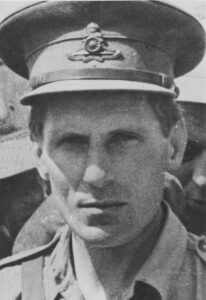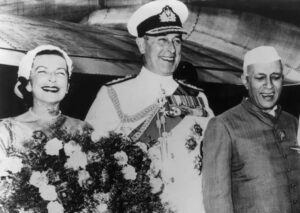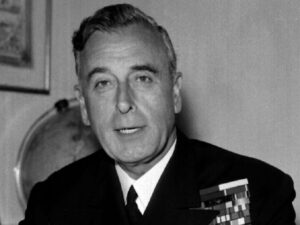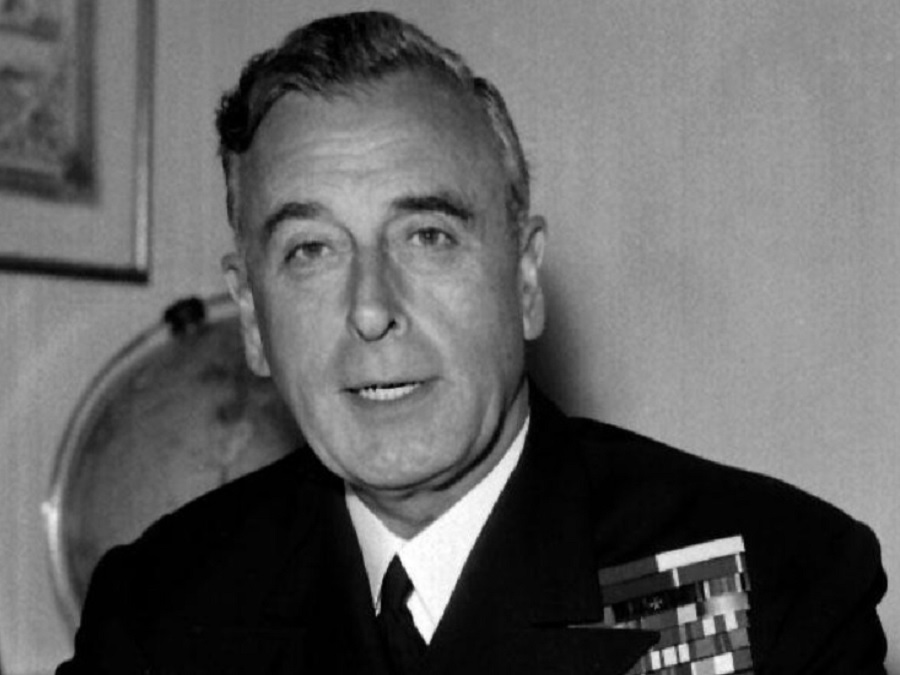Bloomsbury has recently published two books relating to Lord Louis Mountbatten, one of the two Supremos of World War II (the other being Eisenhower). One is about how the news media covered the India-Burma War as the Japanese tried to gain victory there. This is the sphere of war Mountbatten was in charge of. The other book is closely focused on the great war hero himself, from the end of the war against Japan through the years of the Cold War against the Soviet Union.
The media-related book is written by Philip Woods, until recently Distinguished Research Fellow and lecturer at New York University. Prior to that he taught at the Univ. of West London and Kingston University, UK.
Since the Ministry of Information in the UK took little part in the media management of the Burma War, it devolved the initiative to the local services’ public relations organisations. This downgrading of the war coverage reflected Churchill’s own view. He “regarded Burma as very low in Allied priorities” until Germany was defeated. Even the government office charged with Burma was described by an MP at the time as “little more than a bicycle shed at the back of the building.” The land war against Japan was terrible and morale was not helped as the troops were tagged as the “forgotten army” even as the war was raging. This undoubtedly served the Japanese very well, giving them cover to perpetrate every level of atrocity known to man. And they did it to our troops from America, the UK, Australia and other countries of the Empire.
The media-savvy Mountbatten transformed this media desert as best he could once he took over as Supreme Allied Commander, South-East Asia in August 1943. The Japanese invasion of Burma began just days after their attack on Pearl Harbor in December 1941, so Mountbatten came into this theatre of war after some 18 months of defeat for our side. The situation was dire, as they were poised to attack India next. How all this was reported to the outside world is the subject of Woods’ book, and he goes to great pains to distinguish was reporting from propaganda.
There is ‘black propaganda’ which “hides its sources in the aim of discrediting opponents while white propaganda makes it clear that its source is. Black propaganda was rarely used in the Burma War.” Even George Orwell (of 1984 fame) was adamant in “maintaining truthfulness in his broadcasts to India for the BBC, but he still accepted that he was in fact a propagandist.”
In addition to that, war correspondents were faced with a more serious enemy: not the Japanese but military censorship. One of the most respected media guys was from Australia. Douglas Wilkie wrote for three newspapers: the Herald in Melbourne, the Sun in Sydney and the Evening Standard in London. “He showed a grasp of the broader strategic situation that was more normally the function of the professional military correspondent at home than the war correspondent reporting from the battlefront.” One of his reports from January 1943 “was a realistic assessment of the difficulties facing any Allied attempt to recapture Burma by a land operation.” Once Mountbatten took over, he agreed, but his plans for a naval attack was hampered by lack of suitable ships that were needed in the European theatre of war.
However, they did not meet as Wilkie left his post in protest in February 1943. “The whole issue of military censorship blew up when the British magazine The Newspaper World published an article entitled ‘War Correspondents in India Dissatisfied with Official Treatment – Australian leaves as a Protest.” Wilkie said that out of 12 articles he had recently written, at least three were completely stopped. But Woods did his research, and found that Wilkie may not have known “some of his longer dispatches had actually passed censorship and reached the Australia press.” Wilkie had asserted all reference to climate was deleted from his dispatches, but Woods states “weather conditions in Burma” were actually published. One wonders how Wilkie could not have known!
One photograph in the book says volumes about how this attitude towards journalists changed. On page 73 we see the Supremo talking to several correspondents who staged a strike about censorship in 1944. Back in early 1943 Wilkie had no one in high command willing to give him a hearing, but Mountbatten confronted the situation head on by meeting with the journalists during a visit to the front in April 1944, and he met with correspondents again in May at his HQ in Ceylon.

The British General Orde Wingate was a media darling, and “he was keen on getting as much media exposure as possible” for his expedition in Burma. Journalists accompanied him on a campaign “that proved ordinary soldiers could operate in the distant jungle, provided they were supported by aircraft, called in by wireless radio.” By showing the Japs were not “invincible masters of the jungle,” he did much to ensure our ultimate victory. “The immediate publicity of the Wingate expedition in the British press,” writes Woods, “was prominent and very positive.” The campaign made him so famous that Churchill invited him to the Quebec Conference in August 1943, where future war strategy was decided upon by the Allied leaders.
Mountbatten ramped up the publicity campaign in 1945, giving the green light to the creation on a British-made film entitled Burma Victory. It was finally released to British cinemas in November 1945, but as this was after he had accepted the Japanese surrender in September, it had no effect on the war effort. With the “forgotten” tag always lurking in the mind, Wood makes it clear what the film meant for posterity. “The quality of film that went into Burma Victory is testament to the value of the work of the various film and photographic units, which ensured that those who participated in the Burma campaign would never be forgotten.” They will not be forgotten by me. I accompanied the Burma veterans as they left Toronto in 1979 for Mountbatten’s funeral (I had most recently seen Mountbatten in 1978). Woods mentions that Vera Lynn entertained troops in Burma during the war, although he does not say exactly when or where. I was with the Burma vets one last time in Toronto in 1981, when Vera Lynn sang to us all outside Union Station.
The second book under review is by Adrian Smith, Emeritus Professor of Modern History at the Univ. of Southampton, UK. His meticulous study of Mountbatten over a period of 34 years is masterful.
The book begins where the Woods book ends, with some overlap. In boosting army morale, Smith writes, “a stage appearance by Vera Lynn with personal messages straight from home” was a big boost. “When back home Mountbatten found time to brief journalists, both on and off the record – throughout his career he was the supreme propagandist.”
Smith highlights Mountbatten’s “talents as a diplomat, not least in charming Madame Chiang Kai-Shek and massaging the egos of the American generals Stilwell and MacArthur. Also evident was a readiness to take personal responsibility for vital operational decisions.” Smith writes that “The supremo’s presumption that air power was the key factor in waging war, his recognition that supreme command was an essentially executive role and his capacity to work with the most unaccommodating of allies, all constituted key aspects of Mountbatten’s later career.” With his direct line to the sovereign (He was the uncle of Prince Philip, husband of Elizabeth who became The Queen in 1952) and unique relationship with successive Prime Ministers, Mountbatten was “like no other chief” in the UK military.
But the author also makes it clear Mountbatten was not just a military executive and diplomat. “Whether setting up a high-frequency wireless station or micro-managing railway and road improvements in East Bengal, Mountbatten displayed a familiar engagement with fresh thinking in applied science and engineering.” In the 1950s he focused on the maritime application of nuclear propulsion and weaponry. An entire chapter is devoted to nuclear submarines.
Once World War II ended, Mountbatten achieved the highest position any British citizen could hold: he became Viceroy of India. Able to essentially act with the power of the King-Emperor back home (George VI), he created both the modern state of India and the new country of Pakistan. Successive Viceroys “were incapable of imposing their authority,” but he was able to do it in just three months. Both India and Pakistan remained as members of the British Commonwealth upon gaining their independence under his watch. “On 25 July 1946 the Viceroy convened a grand assembly of the Princes, massaging their egos while firmly pointing out that survival depended on each of them making the necessary choice of joining India or Pakistan. Karachi and New Delhi saw scenes of great drama.” As Smith succinctly puts it, for Mountbatten “every crisis was an opportunity.” But he did not do it alone. His wife, Edwina, was key: “the vital force in a radical reshaping of the Raj in its dying days was clearly the Vicereine.” When it was all over, the head of government, PM Attlee, met Mountbatten and his wife at the airport in England. Soon, Mountbatten was commanding the Mediterranean fleet, and in 1955 he returned to the Admiralty as Chief of the Naval Staff. “The last Viceroy could have paid a heavy price for his time in India, but in the end he successfully reached the top of the tree.”
Even Mountbatten could not have foreseen the tremendous peril he would face in 1956 during the Suez Crisis. Should he resign, or stay in place? That question is examined in detail by Smith, as the new PM, Anthony Eden, blundered into a catastrophic invasion of Egypt. Unlike Eden, Smith writes, Mountbatten “was demonstrably up to the job. Time and again Mountbatten felt he could take on the task, suppressing or squaring self-doubt in a way Eden demonstrably could not.”

In 1957 Macmillan had taken over as Prime Minister (I saw him in his later years), and he was visited in July by India’s PM Nehru. The author tells us that Macmillan’s visit to India ten years earlier had fueled a residual ill will towards Nehru, who spent a first “Miserable night at Chequers,” the country home of the English PM. But luckily Mountbatten was there to save UK-India relations. “He urged Macmillan to hold a further meeting with Nehru, focusing upon specific issues rather than sharing a broad brush overview of global tensions. Second time around, both men discovered a surprising amount in common, and the meeting ended with Nehru inviting his host to visit India.”
The President of Cyprus, Archbishop Makarios, is also featured in the book with a photo of him meeting Mountbatten in 1965 on pg. 178. (I met Makarios on a trip to London for the Commonwealth Conference). Here, the book is lacking. Their meeting is told of on page 105, even though the photo appears 73 pages later. He is also indexed under the letter A, instead of M.
If one had to extract a single sentence from this book that best described its subject, I would offer this one, regarding his interaction with the Chiefs of Staff. Keep in mind that in the 1960s he was Chief of the Defence Staff (CDS), the highest of all military positions. “In Mountbatten they came face to face with a supremely confident military commander who would not hesitate to tell the brightest, and most bemedaled colleague that they were wrong, and should act according to his wishes and not their own.”
Both of these excellent books are the result of many years of study. They not only fill an important gap in 20th century history, but serve to remind us, 80 years on from the war, of the pivotal role played by Mountbatten in creating the world order that has prevented another great war.
The Woods book has 2 typos: “an another” on page 21 should be “another”; and “that that” on 72 should be “that”
Managing the Media in the India-Burma War lists for $103.50
Mountbatten, Cold War and Empire, 1945-79 lists for $103.50
Both books are by Bloomsbury
Visit the memorial website to honour Lord Mountbatten:
https://www.lordmountbattenofburma.com/links
The Burma Victory film can be seen on You Tube at this link:
https://www.youtube.com/watch?v=nrAIxbGj9FA&t=1520s
https://www.youtube.com/watch?v=nrAIxbGj9FA
